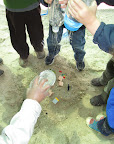Soil erosion in miniature
By Peggy Ashbrook
Posted on 2013-05-13
 With the heavy spring rains in my neighborhood there has been some erosion of soil on a slope in the park and soil from the baseball field has been washed across the sidewalk. There are not many fiction or non-fiction books for young children that include a discussion about soil erosion, or erosion in general. If your class becomes interested in learning about erosion, they can write their own story, and illustrate it with photos or drawings of places where they saw soil washed away by water or blown away by wind. See the resources on “dialogic reading,” listed at the bottom, to learn how this interactive shared reading experience with an adult and a few children supports gains in reading.
With the heavy spring rains in my neighborhood there has been some erosion of soil on a slope in the park and soil from the baseball field has been washed across the sidewalk. There are not many fiction or non-fiction books for young children that include a discussion about soil erosion, or erosion in general. If your class becomes interested in learning about erosion, they can write their own story, and illustrate it with photos or drawings of places where they saw soil washed away by water or blown away by wind. See the resources on “dialogic reading,” listed at the bottom, to learn how this interactive shared reading experience with an adult and a few children supports gains in reading.
 Children can make a model of a neighborhood in sand in a plastic tub or in the sandbox and then make it “rain” to demonstrate erosion.
Children can make a model of a neighborhood in sand in a plastic tub or in the sandbox and then make it “rain” to demonstrate erosion.
 If indoors, use a tray or baking pan with sides 6-9cm tall, and make a layer of damp sand that halfway fills the pan. Have children shape the sand into a landscape with hills, mesas, valleys, river channels and depressions for ponds. Because sand allows water to flow between the grains, their rivers and ponds will not hold water, but water will flow down towards the low points in their landscape before sinking into the sand. Provide many small objects for children to use to create a scene to represent their community—small blocks for buildings, pieces of bias tape or strips of cardboard for roads, twigs for people, pebbles for animals, and small leaves for trees.
If indoors, use a tray or baking pan with sides 6-9cm tall, and make a layer of damp sand that halfway fills the pan. Have children shape the sand into a landscape with hills, mesas, valleys, river channels and depressions for ponds. Because sand allows water to flow between the grains, their rivers and ponds will not hold water, but water will flow down towards the low points in their landscape before sinking into the sand. Provide many small objects for children to use to create a scene to represent their community—small blocks for buildings, pieces of bias tape or strips of cardboard for roads, twigs for people, pebbles for animals, and small leaves for trees.
When their set-up is complete, have them draw or photograph it. Change the setting on the spray bottle to a single stream, or provide an empty condiment bottle with a single hole. The children can now spray or pour more water to move the sand and observe how moving (eroding) the sand affects their community. Have them stop and draw or photograph the set-up as it changes. When the children are finished eroding their landscape, pour the water off outside because wet sand can clog a sink.
Have the children use their drawings and photographs as illustrations for a book. Ask them to write or dictate what they saw happening, and add any comments that you wrote down during the activity. This is your class’s book about erosion!
Here are two resources about “dialogic reading,” a way for children to get the most out of storytime.
“Getting the Most Out of Picture Books,” a video series on dialogic reading from the Getting Ready to Read pages of the National Center for Learning Disabilities, Inc.
“Lap Reading with Kindergarteners” by Herman T. Knoph and H. Mac Brown in Young Children September 2009.
Disclaimer: The views expressed in this blog post are those of the author(s) and do not necessarily reflect the official position of the National Science Teaching Association (NSTA).


